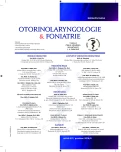The Role of Sialoendoscopy in Mini Invasive Therapy of Sialolithiasis
Authors:
J. Rotnágl
; M. Plánička; M. Navara; J. Astl
Authors‘ workplace:
ORL klinika 3. LF UK a Ústřední Vojenské nemocnice Praha
Published in:
Otorinolaryngol Foniatr, 63, 2014, No. 4, pp. 220-226.
Category:
Original Article
Overview
Sialolithiasis is the most frequent cause of chronic obstruction of salivary glands and is responsible, according to various authors, for 60 – 80 % of all benign obstruction pathologies. Until very recently the resection intervention was the standard therapeutic procedure in cases of non palpable concrements. A technical progress in the nineties of the last century enabled endoscopy to be incorporated into these problems and made also dynamic development of mini invasive functional therapy possible. At the present time sialolithiasis, mini invasive surgery and ultrasonography navigated lithotripsy (ESWL) are the most frequently used methods in mini invasive therapy of sialolithiasis. Indications of the individual techniques are governed by a specific finding, but they partly overlap and can be combined.
In the present cohort the authors summarized their first experience with sialoendoscopy. The attention was particularly devoted to its role in diagnostics and therapy of sialolithiasis. In 160 patients with clinical manifestations of chronic obstruction disease of salivary gland in authors performed 1833 sialoendoscopy interventions from the half of 2009 to the half of the 2013 year. The study was retrospectively prospective. Sialolithiasis was established in 72% of the cases. The concrements found by endoscopy were removed by sialoendoscopy or mini invasive interventions or their combination. The cohort of specified by local anesthesiology only. In the concrements found distally of the gland hilus the size and distance from the orifice of the influenced only the type and complexity of the subsequently selected technique for removal, but it did not influence success of the elimination. In sizable concrements found in the hilus of submandibular salivary gland, where the size did not enable intraductal endoscopic manipulation, local anesthesia proved to limiting factor of successful intraoral sialectomy in our view and experience. In the proximal ramification of the gland parenchyma only the concrements smaller than 3 mm had real expectation of the intraductal removal. Sialoendoscopy as a monotherapy was successfully used only in a small number of patients. However, when combined with techniques of mini invasive therapy, the elimination of concrements proved to be complete in 61% of patients. In conditions of general anesthesia in the group of patients with sizable submandibular lithiasis of submandibular salivary gland the potential for mini invasive therapy in our group theoretically increased to 82%. In the case of ESWL availability a further increase in percentual success rate may be expected to occur in mini invasive therapy. The diagnostic contribution of sialoendoscopy became obvious is 21% of falsely negative ultrasonographic examinations. In our experience sialoendoscopy univocally confirmed its principal importance in mini invasive therapy of sialolithiasis. In order to reach a high success rate in the therapy of sialolithiasis, sialoendoscopy should be combined with other techniques and, is indicated cases, with general anesthesia.
Keywords:
sialoendoscopy, sialolithiasis, mini invasive therapy, local anesthesia
Sources
1. Capaccio, P., Bottero, A., Pompilio, M. et al.: Conservative transoral removal of hilar submandibular salivary calculi. Laryngoscope, 115, 2005, 4, s. 750-752.
2. Capaccio, P., Torretta, S., Ottavian, F. et al.: Modern management of obstructive salivary diseases. Acta Otorhinolaryngol. Ital., 27, 2007, 4, s. 161-172.
3. Durbec, M., Dinkel, E., Vigier, S. et al.: Thulium-YAG laser sialendoscopy for karotidand submandibular sialolithiasis. Lasers Surg. Med., 44, 2012, 10, s. 783-786.
4. Escudier, M. P., Brown, J. E., Drage, N. A. et al.: Extra-corporeal shockwave lithotripsy in the management of salivary calculi. Br. J. Surg., 90, 2003, 4, s. 482-485.
5. Escudier, M. P., McGurk, M.: Symptomatic sialoadenitis and sialolithiasis in the English population, an estimate of the cost of hospital treatment. Br. Dent. J., 186, 1999, 9, s. 463-466.
6. Iro, H., Zenk, J., Escudier, M. P. et al.: Outcome of minimally invasive management of salivary calculi in 4,691 patients. Laryngoscope, 119, 2009, 2, s. 263-268.
7. McGurk, M.: Controversies in the management of salivary gland disease Oxford University Press, 2001.
8. McGurk, M., Escudier, M. P., Brown, J. E.: Modern management of salivary calculi. Br. J. Surg., 92, 2005, 1, s. 107-112.
9. McGurk, M., MacBean, A. D., Fan, K. F. et al.: Endoscopically assisted operative retrieval of parotid stones. Br. J. Oral. Maxillofac. Surg., 44, 2006, 2, s. 157-160.
10. Nahlieli, O., London, D., Zagury, A. et al.: Combined approach to impacted parotid stones. J. Oral. Maxillofac. Surg., 60, 2002, 12, s. 1418-1423.
11. Nahlieli, O., Iro, H., McGurk, M., Zenk, J. Modern management preserving the salivary glands. Edited and with contributions by Oded Nahlieli, IsraDon, Herzliya, 2007.
12. Zenk, J., Bozzato, A., Winter, M. et al.: Extracorporeal shock wave lithotripsy of submandibular stones: evaluation after 10 years. Ann. Otol. Rhinol. Laryngál., 113, 2004, 5, s. 378-383.
13. Zenk, J., Constantinidis, J., Al-Kadah, B. et al.: Transoral removal of submandibular stones. Arch. Otolaryngol. Head Neck Surg,., 127, 2001, 4, s. 432-436.
14. Zenk, J., Gottwald, F., Bozzato, A. et al.: Submandibular sialoliths. Stone removal with organ preservation. HNO, 53, 2005, 3, s. 243-249.
15. Zenk, J., Koch, M., Klintworth, N. et al.: Sialendoscopy in the diagnosis and treatment of sialolithiasis: a study on more than 1000 patients. Otolaryngol. Head Neck Surg,, 147, 2012, 5, s. 858-863.
Labels
Audiology Paediatric ENT ENT (Otorhinolaryngology)Article was published in
Otorhinolaryngology and Phoniatrics

2014 Issue 4
Most read in this issue
-
Anomaly of the First Branchial Cleft
(Cysts, Fistulas, Sinuses) - Mucosal Pemphigoid – Diagnostic Obstacles
- The Role of Sialoendoscopy in Mini Invasive Therapy of Sialolithiasis
- Possibilities of Surgical Use of Thulium Laser in Otorhinolaryngology of the Child Patients
